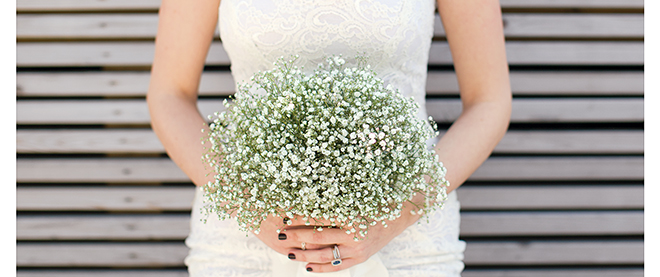Baby’s breath elbows its way into bouquets
Then goes solo and steals the show. The dreaded carnation isn’t far behind, either.
Photograph by Jenna Marie Wakani
Share

Plans for Ashley Varey’s summer wedding hit a snag last month when her choice of flowers sent shock waves through her bridal party. “My mom said they’re hideous and cheap,” reported 28-year-old Varey, who lives in Guelph, Ont. “My maid of honour was horrified. I had to bring her to the florist so she could see them, but then she came around.” Brides like Varey, following the lead of event planners and floral designers, have been quietly rehabilitating baby’s breath or gypsophila, just “gyp” to florists. It’s no longer taboo. Nor is it cheap filler tucked behind the roses. It’s going solo as the dominant floral element in centrepieces and bouquets.
If this is an assault on your sense of style, you’re probably of a certain age. Back in the 1980s, it was nearly impossible to get flowers unaccompanied by baby’s breath. Recipients of those corsages and bouquets tend to recoil from gyp, seeing it as the mullet of flowers. That generation grew up to prefer calla lillies and daisies. “People under 35 have nothing against baby’s breath, if they even know what it is,” laughed Joseph Delarge, owner of Eco Stems in Toronto. Delarge used mounds of gyp to enchant guests at a Toronto fundraiser in February. “Clients come in and show me the Pinterest page for baby’s breath,” noted Casey Schwartz of Flower Duet in Torrance, Calif., where she just did two back-to-back winter weddings with gypsophila as the exclusive bridal flower. And Toronto florist Caspar Haydar is filling the Gerry and Nancy Pencer Brain Trust Gala later this month with big hanging balls of it. “Baby’s breath used to be so passé, but Caspar brought it to a different level,” said the gala’s host, Stacey Cynamon. “The first time I saw it was at a bridal trunk show he did in April. It blew my mind.”
One of the first to reclaim baby’s breath was celebrity florist Eric Buterbaugh, located in the Four Seasons Hotel Los Angeles in Beverly Hills. “I used it en masse,” said Buterbaugh, whose clients include Salma Hayek and Naomi Campbell. “The event was Paul McCartney’s wedding to Heather Mills in an Irish castle. I had trucks of baby’s breath driven over from Holland. We made a 50-foot hedge and huge arches. It acted like a soft-focus lens, making everything beautiful. But only outside the castle, because baby’s breath can smell a bit like urine.”
For that reason, not all florists are charmed by gyp. Jean-Pascal Lemire of Bouquet Fleuriste, located in the Ritz-Carlton in Montreal, won’t stock it in because of the “terrible aroma.” It’s also too shabby chic for his taste. “It’s a DIY flower that Martha Stewart puts forward because she wants to sell you her little mason jars,” he said. But he’s a big champion of another rehabilitated flower from the 1980s, the carnation. The much-maligned bloom has seen a 30 per cent spike in demand since Christmas at Canada’s Sierra Flower Trading, one of the bigger importers and distributors to wholesalers across Canada. The majority of the orders were not for traditional colours like red or white. Florists want new vibrant shades: burgundy, tea green, hot pink, violet. “Do you know how hard it is to get a deep purple flower?” said Lemire. “I present one colour, packed tightly until they make a big ball that doesn’t even look like a carnation anymore. It takes you a minute to figure out what it is. The new generation of brides at the Ritz-Carlton get it.”
Emerging couture florists appreciate the wow factor of uniform mass, so flowers with a lower stem price just make sense. Jessica Blossom Clark built a five-by-five-foot display of white gladiolas for a recent wedding in Vancouver: “At under $3 a stem, glads give me freedom to go big.” Carnations are even cheaper, at $1 to $2 a stem. A rose, by comparison, costs between $5 and $10. “At that price, I can carpet things with carnations,” said Vancouver floral designer Soha Lavin. “I use them on tables, instead of linen, under a glass top. The table has so much impact that people forget they hate carnations.”
In 30 years, what will be looked back on as the mullet flower of the 2010s? “Maybe gerbera daisies, which are lovely, but overexposed,” predicted Lemire. “But in the hands of artists, they’ll eventually become new again.”